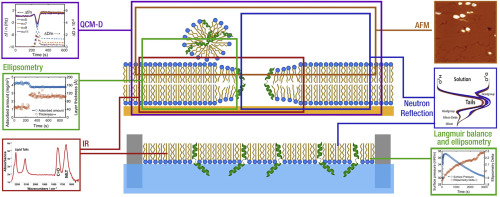当前位置:
X-MOL 学术
›
Adv. Colloid Interface Sci.
›
论文详情
Our official English website, www.x-mol.net, welcomes your
feedback! (Note: you will need to create a separate account there.)
Design and use of model membranes to study biomolecular interactions using complementary surface-sensitive techniques.
Advances in Colloid and Interface Science ( IF 15.9 ) Pub Date : 2020-01-30 , DOI: 10.1016/j.cis.2020.102118 Luke A Clifton 1 , Richard A Campbell 2 , Federica Sebastiani 3 , José Campos-Terán 4 , Juan F Gonzalez-Martinez 3 , Sebastian Björklund 3 , Javier Sotres 3 , Marité Cárdenas 3
Advances in Colloid and Interface Science ( IF 15.9 ) Pub Date : 2020-01-30 , DOI: 10.1016/j.cis.2020.102118 Luke A Clifton 1 , Richard A Campbell 2 , Federica Sebastiani 3 , José Campos-Terán 4 , Juan F Gonzalez-Martinez 3 , Sebastian Björklund 3 , Javier Sotres 3 , Marité Cárdenas 3
Affiliation

|
Cellular membranes are complex structures and simplified analogues in the form of model membranes or biomembranes are used as platforms to understand fundamental properties of the membrane itself as well as interactions with various biomolecules such as drugs, peptides and proteins. Model membranes at the air-liquid and solid-liquid interfaces can be studied using a range of complementary surface-sensitive techniques to give a detailed picture of both the structure and physicochemical properties of the membrane and its resulting interactions. In this review, we will present the main planar model membranes used in the field to date with a focus on monolayers at the air-liquid interface, supported lipid bilayers at the solid-liquid interface and advanced membrane models such as tethered and floating membranes. We will then briefly present the principles as well as the main type of information on molecular interactions at model membranes accessible using a Langmuir trough, quartz crystal microbalance with dissipation monitoring, ellipsometry, atomic force microscopy, Brewster angle microscopy, Infrared spectroscopy, and neutron and X-ray reflectometry. A consistent example for following biomolecular interactions at model membranes is used across many of the techniques in terms of the well-studied antimicrobial peptide Melittin. The overall objective is to establish an understanding of the information accessible from each technique, their respective advantages and limitations, and their complementarity.
中文翻译:

使用互补的表面敏感技术设计和使用模型膜来研究生物分子相互作用。
细胞膜是复杂的结构,模型膜或生物膜形式的简化类似物被用作了解膜本身的基本特性以及与各种生物分子(例如药物,肽和蛋白质)相互作用的平台。可以使用一系列互补的表面敏感技术研究气-液和固-液界面处的模型膜,以详细描述膜的结构和理化性质及其相互作用。在这篇综述中,我们将介绍迄今为止在该领域中使用的主要平面模型膜,重点是气液界面处的单层膜,固液界面处的支持脂质双层以及先进的膜模型,例如栓系膜和浮膜。然后,我们将简要介绍使用Langmuir槽,带有耗散监测的石英晶体微量天平,椭圆偏振光度法,原子力显微镜,布鲁斯特角显微镜,红外光谱法以及中子和中子分析法可访问的模型膜上分子相互作用的原理和主要信息类型。 X射线反射法。关于模型膜上生物分子相互作用的一个一致的例子,是在许多技术方面都使用了经过充分研究的抗菌肽Melittin。总体目标是建立对每种技术可访问信息的理解,它们各自的优点和局限性及其互补性。石英晶体微量天平,具有耗散监测,椭圆仪,原子力显微镜,布鲁斯特角显微镜,红外光谱以及中子和X射线反射仪。关于模型膜上生物分子相互作用的一个一致的例子,是在许多技术方面都使用了经过充分研究的抗菌肽Melittin。总体目标是建立对每种技术可访问信息的理解,它们各自的优点和局限性及其互补性。石英晶体微量天平,具有耗散监测,椭圆仪,原子力显微镜,布鲁斯特角显微镜,红外光谱以及中子和X射线反射仪。关于模型膜上生物分子相互作用的一个一致的例子,是在许多技术上都使用了经过充分研究的抗菌肽Melittin。总体目标是建立对每种技术可访问信息的理解,它们各自的优点和局限性及其互补性。关于模型膜上生物分子相互作用的一个一致的例子,是在许多技术方面都使用了经过充分研究的抗菌肽Melittin。总体目标是建立对每种技术可访问信息的理解,它们各自的优点和局限性及其互补性。关于模型膜上生物分子相互作用的一个一致的例子,是在许多技术方面都使用了经过充分研究的抗菌肽Melittin。总体目标是建立对每种技术可访问信息的理解,它们各自的优点和局限性及其互补性。
更新日期:2020-01-31
中文翻译:

使用互补的表面敏感技术设计和使用模型膜来研究生物分子相互作用。
细胞膜是复杂的结构,模型膜或生物膜形式的简化类似物被用作了解膜本身的基本特性以及与各种生物分子(例如药物,肽和蛋白质)相互作用的平台。可以使用一系列互补的表面敏感技术研究气-液和固-液界面处的模型膜,以详细描述膜的结构和理化性质及其相互作用。在这篇综述中,我们将介绍迄今为止在该领域中使用的主要平面模型膜,重点是气液界面处的单层膜,固液界面处的支持脂质双层以及先进的膜模型,例如栓系膜和浮膜。然后,我们将简要介绍使用Langmuir槽,带有耗散监测的石英晶体微量天平,椭圆偏振光度法,原子力显微镜,布鲁斯特角显微镜,红外光谱法以及中子和中子分析法可访问的模型膜上分子相互作用的原理和主要信息类型。 X射线反射法。关于模型膜上生物分子相互作用的一个一致的例子,是在许多技术方面都使用了经过充分研究的抗菌肽Melittin。总体目标是建立对每种技术可访问信息的理解,它们各自的优点和局限性及其互补性。石英晶体微量天平,具有耗散监测,椭圆仪,原子力显微镜,布鲁斯特角显微镜,红外光谱以及中子和X射线反射仪。关于模型膜上生物分子相互作用的一个一致的例子,是在许多技术方面都使用了经过充分研究的抗菌肽Melittin。总体目标是建立对每种技术可访问信息的理解,它们各自的优点和局限性及其互补性。石英晶体微量天平,具有耗散监测,椭圆仪,原子力显微镜,布鲁斯特角显微镜,红外光谱以及中子和X射线反射仪。关于模型膜上生物分子相互作用的一个一致的例子,是在许多技术上都使用了经过充分研究的抗菌肽Melittin。总体目标是建立对每种技术可访问信息的理解,它们各自的优点和局限性及其互补性。关于模型膜上生物分子相互作用的一个一致的例子,是在许多技术方面都使用了经过充分研究的抗菌肽Melittin。总体目标是建立对每种技术可访问信息的理解,它们各自的优点和局限性及其互补性。关于模型膜上生物分子相互作用的一个一致的例子,是在许多技术方面都使用了经过充分研究的抗菌肽Melittin。总体目标是建立对每种技术可访问信息的理解,它们各自的优点和局限性及其互补性。











































 京公网安备 11010802027423号
京公网安备 11010802027423号